
It is believed that moles are afraid of sharp unusual smells, loud noise and even the presence of some plants on the site. As a result, they simply do not try to scare away the animals from the garden - with carbide, and rotten fish, kerosene, smoke bombs, and sometimes urine poured directly into wormholes.
About what means can really help, and which of them are practically useless, as well as what moles are most afraid of - we will talk more about all this in more detail.
But for starters, it should be borne in mind that in practice it is often not so rosy and simple with frightening agents as we would like. For example, if ordinary rotten fish could easily and with 100% efficiency remove moles on a site, then you would not have to come up with more complex and expensive methods of getting rid of moles - all kinds of traps, electronic repellers, and barriers.
In addition, just theoretically knowing what the mole is afraid of is not enough, since you still need to be able to correctly apply such a deterrent in practice, taking into account the specifics of the underground communications of the animals, their habits and biological features, as well as the potential harm to the used means for the site itself land.
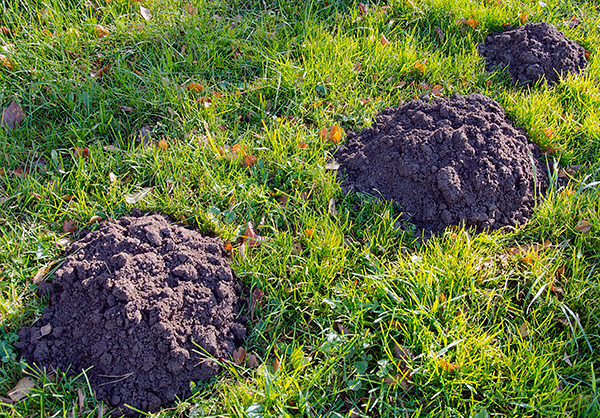
So, let's see what is useful to know about the most popular ways to scare away moles, and let's start with the "classics of the genre" - calcium carbide ...
Mole Carbide: Difficult, Dangerous, and Unreliable ...
As practice shows, mole carbide sometimes really helps. But by no means always, and there are situations when, after using carbide, moles seem to start digging moves even more actively. Why is this happening?
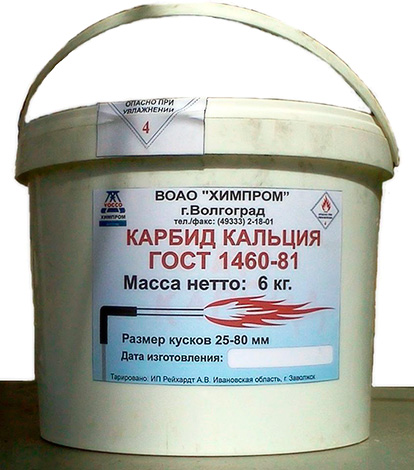
Calcium carbide is a chemically rather active substance, and when its pieces are placed in the ground, it gradually reacts with moisture, releasing acetylene gas. In addition, technical carbide always contains impurities of arsenide and calcium phosphide, which, when reacted with water, produce strongly smelling arsine and phosphine, respectively, as well as some of their derivatives. These compounds have an unpleasant odor and are also very toxic.
Although the concentration of arsine and phosphine in the gas released from carbide is low and will not kill the animal during a not very long exposure, nevertheless, the unpleasant odor will frighten off moles, forcing them to actively dig new moves and make more ventilation outlets to the earth's surface (mole heaps). Therefore, immediately after the application of carbide, the apparent effect may be the opposite of the expected one - there will be more fresh heaps of earth.
On a note
If you place a piece of calcium carbide in moist soil, it quickly interacts with moisture and loses its deterrent activity, turning into a highly alkaline calcium hydroxide. Therefore, you should not abuse the tool - regular strong alkalization of the earth can harm plants growing in the garden, as well as microorganisms in the soil.

Nevertheless, sometimes just laying pieces of carbide in moleholes actually allows you to get rid of moles, and the animals leave in search of more comfortable conditions (although they may later return back).
Some gardeners use carbide to carry out the fight against moles more strictly: they put the pieces in plastic bottles, fill them with water, and then place such acetylene generators in the excavated underground passages and bury them. The calculation here is based on the fact that the released acetylene displaces oxygen from the worms and leads to asphyxiation of the animals.
Unfortunately, the flashing idea of some sophisticated mole fighters does not stop there - sometimes the animals are destroyed, first filling the passages with acetylene with carbide, and then burning the resulting acetylene-air mixture.

However, even these far from humane, barbaric methods of fighting moles may not give the desired result: there may not be enough gas to strangle animals, acetylene may not explode if its ratio with air is insufficient, and moles can go far in their underground communications from a choking hearth.
Feedback
“I tried to somehow buy carbide for moles. In Radoshkovichi he was not there, I wanted to buy it in Minsk. I found it on the iron one, I already got the money, the seller asked why it was for me, I told. He dissuaded me. He said that there was no point, only to poison the garden. This is terrible chemistry. Advised to buy a simple trap. So, now such a trap is coming to me from Minsk. I’ll check what it is ... "
Mikhail, Radoshkovichi
Brief summary: the use of calcium carbide against moles can hardly be considered justified and effective. Not only does this substance not always scare away animals, it can also kill them (and death will be painful), and it will also destroy many useful inhabitants of the soil, inflicting to one degree or another pronounced damage to the plot of land as a whole. If we take into account the high fire hazard of carbide, then we can conclude that the disadvantages of this tool are much greater than the advantages.
Plants on the site that moles fear
There are many references to the fact that the smell of some plants and just their growth in the area can scare off moles.

For example, it is believed that the number of plants that moles are afraid of includes the following:
- Onions (including leeks and flowering onions);
- Garlic;
- Daffodils;
- Grouse imperial;
- Siberian spelling;
- Marigold;
- Euphorbia caper;
- Black beans (perhaps it is black beans that they try to use most often);
- Castor oil.
Feedback
“I have many familiar gardeners who do not specifically dig up hazel grouse and everything is wonderful with them, no moles. I also planted one bulb, then it was in this flower garden that there were no moles. ”
Svetlana, Moscow
However, in reality there is no statistically reliable evidence that at least some of the above plants actually help get rid of moles in the area. Many opinions that the mole allegedly does not like this or that plant are based approximately on such statements: “I grow black beans every year, and I have never had moles, and my neighbors do not grow them, and constantly struggle with these pests” .
It is also useful to keep in mind the following nuance: moles do not feed on the underground parts of plants, therefore they do not “taste” planted onions, garlic and other plantings. The main food of moles is earthworms and, to a lesser extent, insects and their larvae.
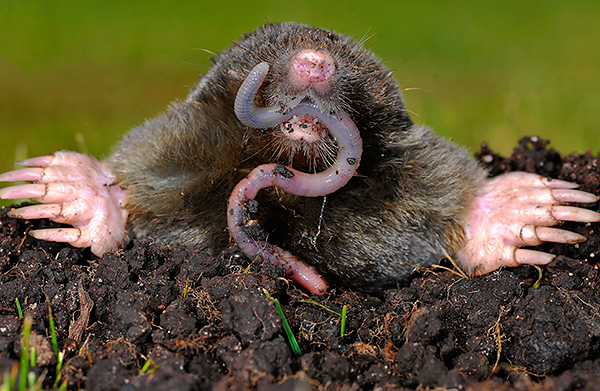
An alternative approach that gardeners sometimes try to practice is to scare away moles with the help of onion husks, which are buried in mole holes. It is also believed that moles do not like the smell of chopped garlic and onions - and this has a certain rational grain, since many living things (and not only warm-blooded animals) do not like the acute smell generated by mechanical damage to these plants. However, the duration of such protection will be very short in time.
Feedback
“I’ll say right away: all kinds of stories about daffodils and grouse from moles are tales! I have these plants growing all my life on the site, and this year I planted more black beans for fun. Moles on the site appeared several times, it did not depend on the presence of flowers and beans. My husband and I caught them with a mole-pipe. These parasites dug everything to us, and fresh beds with garlic, and flower beds with daffodils.Therefore, no plants against moles help! ”
Veronica, Uman

Thus, we can conclude: if moles in the garden are already rampaging, then it will not be enough to plant any flower for the mole to leave - these animals are not so afraid of plants. It’s another matter if you decide to organize a mass planting of flowers, beans or anything else - during this procedure the animal’s moves close to the surface of the earth will inevitably be mechanically destroyed, which with a small probability can force the moles to temporarily relocate to an adjacent area, where the situation is more stable .
About smoke bombs in the fight against moles
If you suddenly want to "smoke" moles from under the ground with the help of smoke bombs, it is useful to take into account a number of important nuances.
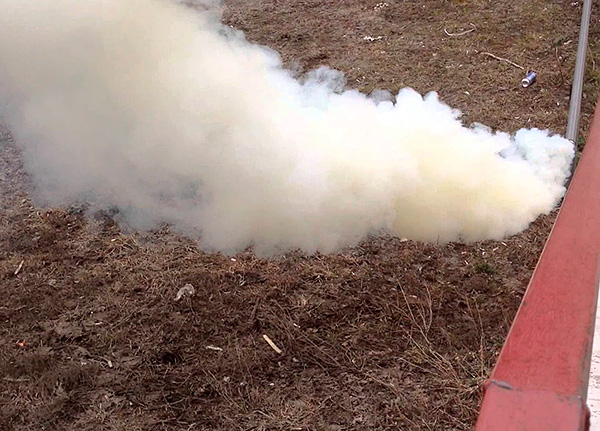
First of all, you need to keep in mind that there are several types of smoke bombs on sale, and not all of them are equally effective and safe:
- Sulfur checkers - usually used to combat mold in a cellar or greenhouse. When burning, they emit sulfur dioxide, which has a pungent odor, strongly irritates the respiratory tract and is toxic in high concentrations. During normal operation of the checker, it burns with an open flame, that is, it will not work to bury it in the mole and sprinkle it with earth, because otherwise the flame will go out. Thus, a sulfur checker will help, perhaps, to remove moles from the cellar or greenhouse, but not from an open plot of land;

- Insecticidal-repellent smoke bombs - used to scare away and kill insects. During the burning (decay) of such pieces, smoke is poisonous to insects, which usually contains insecticides from the pyrethroid group. Due to the pyrotechnic filling, some insecticidal-repellent checkers are able to burn, even when sprinkled with earth. It should be borne in mind that insecticides, when spreading through underground passages, will destroy a significant number of underground microorganisms, and can also get into plants (in particular, in crops). It is especially not recommended to use checkers based on hexachloran (G-17 and analogues), since this substance, otherwise called hexachlorocyclohexane, has carcinogenic and teratogenic activity;


- Smoke bombs used in the army to create curtains, as well as signal ones (with colored smoke) - some of them are also able to burn underground, and the smoke emitted is slightly less toxic to insects and microorganisms than when using insecticidal bombs.

Be that as it may, regardless of whether an insecticide-repellent smoke bomb is used or a signal one, this is not about harmless “smoking” of moles from the ground, but about their destruction right in the underground passages. The animals will not massively crawl to the surface to breathe fresh air, but on the contrary, they will instinctively try to hide from danger precisely under the ground, where they suffocate.
Thus, the method of combating moles with the help of smoke bombs is barbaric (if not sadistic), and in a civilized garden economy it is not recommended for use.
On a note
The use of smoke bombs is in many ways similar to another barbaric way of “scaring away” (and in fact, destroying) moles. To do this, a hose is connected to the exhaust pipe of the car, the end of which is immersed in a mole hole and covered with earth. Moles, of course, are afraid of the smell of smoke and, especially, exhaust gases, but more likely to simply suffocate underground rather than flee to another area.
In general, the use of smoke bombs from moles does not give a guaranteed result. Smoke may not spread throughout the entire system of moves of the animal, and may also begin to emerge from the ground through numerous molehills.
Food-based deterrents
Smelling and spoiled foods are classic mole repellents.Moles are really afraid and avoid many odors of natural food products, and therefore with a certain, though not always high, effectiveness in combating them, you can apply:
- Onion, cut into slices (as well as onion peel);
- Rotten fish and meat;
- Rotten eggs;
- Vinegar (as a concentrated essence).

The challenge is to place a strong-smelling substance in the molehills, giving preference to fresh emissions of land. Having a sensitive scent, the mole feels odors from afar, and sometimes it really abruptly stops all activities on the site, leaving it in search of more comfortable living conditions and underground hunting.
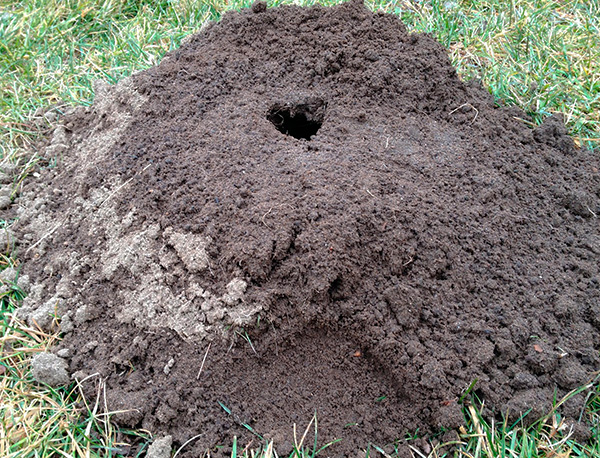
However, this is not always the case. Sometimes the animal continues to dig moves, as if nothing had happened. Strengthening the same measures of impact by digging a rotten herring on the head of a rotten herring on each square meter is also not the most convenient option, and the plot will stink for several weeks.
Feedback
“Last year moles defeated, there was no living from them. I’ve already bought scarers, and put a faded herring, and poured bleach into the holes. And the moles dug right next to it, all to no purpose. Then they bought a Norwegian cat kitten. This year, there are no moles on the site. That is, you can’t even see, not even mice! The cat works all night, hunts. Dangle on the whisker ... "
Veronika, St. Petersburg
Essential oils and products based on them
Essential oils act on moles with about the same efficiency as rotten fish, with the only difference being that oils are much more pleasant to handle. Moreover, so that the chances of getting rid of pests are high enough, the smell of essential oil should be more or less evenly distributed over almost the entire area.
This can be achieved, for example, in the following way:
- A strong-smelling essential oil is bought (sold at pharmacies). The best and most effective option is lavender oil, although pine oil is also suitable, if, fir or cedar. Gum turpentine, camphor or castor oil are also sometimes used;

- Next, the essential oil is added to a simple dough. The bigger, the better;
- Then, balls with a diameter of about 1 cm are rolled from the dough;

- Balls are buried in the ground to a depth of about 20 cm over the entire area at a distance of 1 m from each other, and along the borders - in increments of 50 cm. It is not recommended to bury the balls in mole passages.
By the way, it is on this principle of deterrence that the Detia mole remedy works - balls with lavender extract, made in Germany.
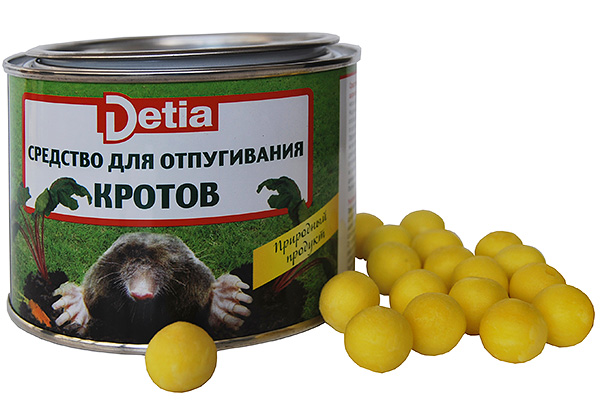
On a note
A similar principle of action is also a popular means of scaring away moles in the form of garlic passed through a meat grinder, mixed with camphor oil. The resulting slurry is poured into the holes on the territory and along the boundaries of the site.
We can’t say that moles are really afraid of the smell of essential oils, but practice shows that animals still try to avoid it. Therefore, although you should not expect total effectiveness from such tools, however, with the right approach, this technique sometimes really helps gardeners drive moles out of the area and protect themselves from new pests from outside.
About repelling moles by other means with a strong smell
Like gardening oils, gardeners sometimes try to use various technical means with a strong odor - kerosene, gasoline, tar. Usually, these liquids are simply poured into the holes of moles, as well as into the holes in the area.
It should be noted that the use of such products is much less preferable than the use of essential oils - because of the increased fire hazard and the harm that these substances cause to the soil.

And even more so, you should not take matters to the extreme by digging human excrement in mole holes or pouring urine into them (some comrades even save whole buckets of urine, so that later they can generously saturate molehills with it - this, of course, is inexpensive, but in the 21st century it looks like, frankly, it is rather doubtful).
On a note
It may seem strange to some, but some people of the old school sometimes seriously expect to drive moles off the site with the help of conspiracies, runes and prayers. It is interesting at the same time that in folk art there is not one conspiracy from moles, but a whole series of them. Needless to say, this method is hopeless without any reservations: neither conspiracies, nor runes, nor prayers affect moles. However, if you have doubts about this, then you can try it if you wish: “Run away from my garden, don’t come into my garden anymore, or you’ll strangle you with a rope, set fire to it, beat it with a stone, and poison it with onion porridge.” Then be sure to unsubscribe in the reviews at the bottom of this page - whether it helped or not 🙂
Repelling moles by sounds: ultrasonic repellers, noisers and firecrackers
One of the most effective ways to scare away moles from a site is to influence them with the help of various sound sources.
There can be many options here:
- The so-called ultrasonic mole repellers. In fact, most of these devices are called ultrasonic by mistake, for the sole reason that they periodically squeak and rattle. However, in most models of electric mole repellers, the emitted frequency is by no means ultrasonic (above 20,000 Hz), but much lower, at the level of 300-1000 Hz. When choosing such devices, preference should be given to models emitting both sound and vibrating at the same time due to a motor with an eccentric, working on the principle of "random" - when the electrical circuit randomly changes the frequency and duration of sound and vibration exposure (to reduce the effect of animal addiction to extraneous noise). Example - mole repeller Ecosniper LS-997MR (aka MOLECHASER LS-997MR);


- Turntables made of plastic bottles or cans and installed on metal rods or pipes stuck into the ground 1-2 meters high. Rotating under the influence of wind, they constantly rumble, which scares away moles (though not always). Such mole rats are easy to make with your own hands

- Glass bottles buried about 2/3 in the ground at an angle of 45 degrees. The wind, blowing into their necks, creates a hum, and many gardeners believe that it scares away moles. However, usually the desired effect is not achieved.

On a note
There is also an informal way to scare away moles with loud music. Proponents of his assure that on the site every day must certainly rattle heavy rock.
Sometimes they just use plastic bottles scattered around the site, which crack when the temperature drops during the day. As well as reed stems stuck near the mole's moves - it is believed that the hum of the stalk in the wind scares moles.
A tougher way to scare away moles with loud sounds is to explode firecrackers in their moves. A variation on this theme is shots from a hunting rifle with a blank cartridge into mole holes.
In conclusion, it is worth noting such a moment: in order to significantly increase your chances of success in the fight against moles, it is advisable to approach the issue comprehensively. For example, combine different types of deterrents, as well as supplement them, at least temporarily or periodically, with mole traps (for example, use a mole trap pipe). In addition, to the extent possible, it is useful to implement protection of the site by means of a barrier type - a lawn net from moles, a perimeter net, or even slate dug into the ground.
And it will be much better than just digging a couple of rotten herrings in the ground, and then complaining - they say, something does not help ...
If you have personal experience using any kind of scaring agent (any), then be sure to share the results by leaving a review at the bottom of this page.
Useful video about electric mole repellers
Fighting moles with firecrackers and ammonia


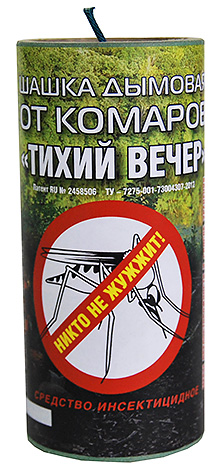
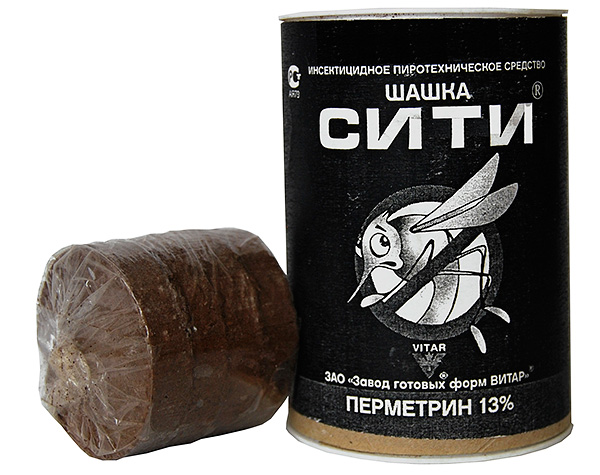
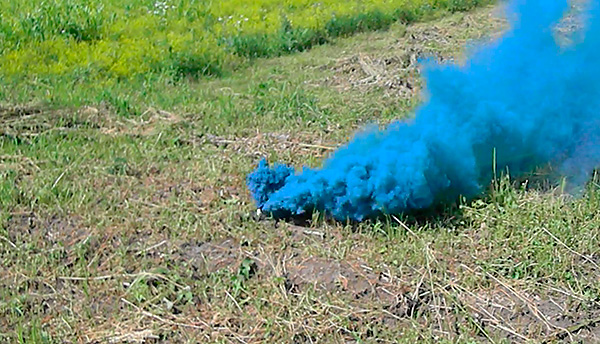

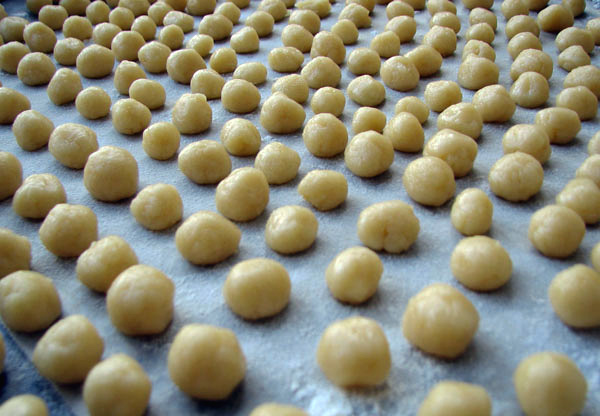





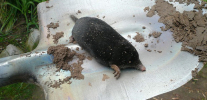

Well, the uncle with a pan and ammonia pleased indescribably! I won’t sleep now, my hands are itching to do the same. These bulldozers rummaged through everything!
Pshikala in the summer on several cylinders of dichlorvos in a course (applied a nozzle tube) - helps. But as soon as they left in the fall - they dug everything up, scum (the perimeter was fenced with a concrete base, they forgot to make a vertical fence under the gates - they climbed, bastards). I will set traps or call a brigade for this, then we will partition under the gate. Unsubscribe from the results.
The fact that they do not like garlic and onions is not true. They only steal it like that. If they do not like him, then why is he found in their dens? Yes, and why do they steal it if it has a strong smell? How will they eat it? )
The author of the article has repeatedly expressed his inhumane attitude towards such cute warm-blooded animals. That they are not to blame for the fact that our beds and lawns inadvertently come across on their way. What they need to be caught and released away from your site! Let us all collect and release Colorado beetles, bears, mice, rats and other pests away from our gardens. All of them are not to blame for what they want to eat!
On my site, too, there is such a problem! The only way to get rid of them is traps. Everything else is mouse fuss. There is an effect from making noise with beer cans on bars, but they don’t solve the problem radically. Moles leave the "troubled" place, but eventually return again! They willingly master manure with worms behind the barn. The feed base attracts them, and breed in the same place. Apparently, they winter there because of the heat from manure.
It is necessary to invent a universal, easy to use and reliable trap. There was a cat before, which often pleased me with the results of its hunt (gray color). Over the summer, 6-8 moles on her account. It was a great relief to us gardeners. Well, we will continue the struggle with these bored underground creatures. Good luck to everyone, continue to look for effective ways to fight. Not true, a way must be found!
I bought two different sound-vibration mole repellers. They stood for six months, the mole went crazy even more, began to dig.
Infusion of rotten fish is used to combat moles and, apparently, is very effective. The other day, my young adult cat died from botulism toxin. Complete paralysis. The doctor did not even think that it was a toxin. He treated a stroke ... In 3 hours the cat was gone.
I began to find out, to search for empty cans of canned goods around the territory of our house (village). I found an empty three-liter jar at a neighbor behind the fence (she sometimes comes to the country to rest), in the bank at the bottom - scales from fish and bone. Apparently already long-standing - dry. The cat's mouth smelled of fish when he was dying. Therefore, I began to look for a reason in another. And found it. I’m calling a neighbor, I’m talking about a jar.She told me - yes, this is an old infusion of rotten fish, I poured its type into minks of moles 3 years ago. There, he says, poison, which is formed from decay. She was 2 days before the death of the cat, she was in the country and cleaned. Apparently, she found a jar and shook the dry residue from the jar. The cat was very fond of fish (and always full). The result is the death of a cat from the smallest particle of dry fish soaked in toxin (butolotoxin).
So the poison from rotten fish is the most effective and cheapest, but to make such a poison and use it is to be completely frostbitten by a person’s head ... I don’t advise doing so. Corrupt everyone and you can.
What a horror, I sympathize with you.
I’ve been fighting moles on my site for several years now. The most effective ones are the mole tube and SuperCat. From one place I catch 5-6 pcs. You just need to choose the right place. They come from outside. If you carefully examine the perimeter of your site, you can determine the entry point along the "path" from the heaps of land going to the border of your site. But there may be more than one entrance. Good luck in the fight against these villains!
There is nothing better than a working trimmer - from the exhaust hose to the hole.
The method is effective. Checked.
This is what helped us. They dug up the mink so that both moves were open. They started a petrol scythe and let off exhaust gas from a scythe through a pipe into the hole, tightly covering the top with a lid. This should be done in April, before nesting. One year, we managed to completely expel the mole. He left on the first day. All summer, not a single heap. And then they missed - and another one came in the fall. In the spring we will smoke again. They say that if not a brushcutter, then you can attach a hose to the exhaust pipe of the car and direct it into the hole.
One way helped. It is necessary to dig a hole in the middle of the cat tunnel. A 5-liter jar or an old pan is inserted on top. The edges of the tank should be flush with the floor of the tunnel. Fill with water and cover with a piece of slate or plywood, and then sprinkle with earth so that light does not penetrate into the tunnel. Wait a couple of days or more, and then get rid of the corpses of moles.
This is a very effective way! At one time, I took out up to three moles. However, the next season, cats began to bury and bypass traps. I am looking for another way.